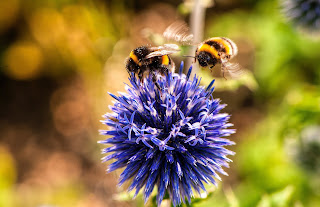You may have noticed nature has flourished in your gardens and other green spaces around your home while we have been going out less. You might have heard the birds singing louder outside your window or spotted a few Hedgehogs. There are lots of ways we can continue to help the wildlife in our gardens and around our homes! We have listed a few tips below to help you make green spaces more welcoming and make the most of the wildlife near you.
It's also not too late to get involved in the
30 days wild/ wildlife from my window campaign!
Click here to find out more and get involved!
1. Let the grass grow
Many of us don’t like the thought of having long grass in our gardens or in the parks but letting grass grow will allow many plant, insect and animal species to thrive. Mowing the grass once a month allows time for ‘short-grass’ plants like daisies and white clovers a chance to flower which boosts nectar production more than ten times! These attract many different types of pollinating insects, especially bees!
 2. Birdbox and Feeding
2. Birdbox and Feeding
Birds are a really important part of the ecosystem and creating bird boxes or putting out food will help them thrive. Whether it’s in your garden or in the park nearby, you could put up a birdbox high in a sheltered area and leave out some bird feed! Protein rich feed or ‘Fat Cakes’ are the best for spring and summer months.
Click here to find out how to make a ‘fat cake’ for birds.
3. Build an insect hotel.
Not only will this benefit the environment, but it can also be a great activity to get the whole family involved! Leave rocks, twigs and rotting wood in a small area of your garden or a green space near you. This will create a shelter for all sorts of important insects!
Click here to find out how to make your own.
4. Make a compost heap
A compost heap is not only great for the environment, it enriches the soil and provides a great habitat for worms, woodlice and many other insects, including frogs! Make sure to only add raw food, not cooked food, or it could become a habitat for mice too!
Click here for tips on how to make a compost heap.
5. Leave a gap in your fence
In the last two decades the population of Hedgehogs in Britain had drastically declined. This is partly due to people fencing in their gardens and the removal of hedges which are a favoured nesting site for the species. One way we can help the Hedgehog population is to leave gaps in the bottom of our fences. This will allow wildlife to move through and link different habitats together, to allow them to find food and a mate more easily.
 6. Grow flowers and climbing plants, and let weeds grow too!
6. Grow flowers and climbing plants, and let weeds grow too!
Flowers, climbing plants and weeds all provide food for many insects, such as bees and butterflies. Grow as many varieties of flowers and climbing plants as possible, and leave nettles and daisies to grow, to allow wildlife to flourish! If you don’t have a garden, use hanging plants outside your window, or a plant window box!
7. Control your pets!
Animals such as Cats, are not a natural part of the food chain, we introduced them. Unfortunately, even though pets are adorable, introducing them has had a huge negative impact on much of our wildlife. It is important that we try to protect wildlife by controlling our animals. For example, by keeping bird feeders out of reach.
Click here to find out more.
8. Volunteer
Volunteering is a great way to help wildlife near you to thrive. Donating your skills and time to supporting wildlife charities will really help to make a difference. There are loads of opportunities available from species surveying to caring for nature reserves!
Click here to find opportunities near you.
Helping wildlife at Herts:
Monica Kanwar, Director of Health, Safety and Sustainability.
“I have really enjoyed watching Chris Packham and his team on Spring Watch, and this year it has been a delight really seeing what the presenters have been finding during lockdown. So, I thought I would share what’s been happening in my garden over the last few weeks.

We have been very lucky to have had great, blue and coal tit families nesting in and around our garden which has been so lovely. My husband, like Chris Packham, is a keen natural history fan and has been moth trapping in our garden. The photo is the Green Pug moth which is so beautiful. He has been sending his records to the iRecord so it helps with the wildlife recording data.
I know on campus at this time of year we should have been seeing the Bee Orchids arrive. I do hope you have had time to take a moment to look at wildlife in your garden or during your walks!”
Images from the Herts Community:
We love seeing your photos of gardens, wildlife and pets. Keep sending them in! Just get in touch via
Twitter, Instagram,
Facebook, or
email.






